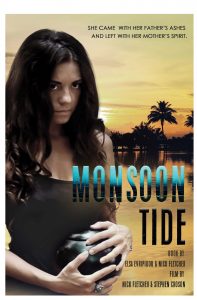PUBLISHED JANUARY/FEBRUARY 2018
by Elsa Evripidou and Nick Fletcher,
Monsoon Tide --

Elsa Evripidou & Nick Fletcher
A lot is being made in the press currently about the relative demise of e-books and the resurgence of their conventionally printed counterparts. Experts in the field have pointed out a number of reasons for this, including:
- People seem to be reconnecting with the printed book form. As the Guardian put it in September 2017, “Readers take a pleasure in a physical book that does not translate well on to digital. Virtual books, like virtual holidays or virtual relationships, are not real. People want a break from another damned screen.” Parents, in particular, are keen to encourage children to read books for precisely this reason.
- Despite the virtues of the e-book—you can carry around a whole bookshelf of titles, and it is instantly accessible and better for the planet—it also has its drawbacks. It is not as easy to navigate back and forth within an e-book as you do with a conventionally printed format, and it doesn’t make a great gift that you can hand over, all beautifully wrapped up.
However, a major factor is that e-books, for the most part, are just replicating conventional books in an electronic format.
Although there have been a number of enhanced e-books that have featured audio tracks, film clips, ambient background noise, and interactive games, these add-ons are merely icing the cake. The story itself can be read without any of these enhancements, and some experts like Curt Matthews have claimed that these enhancements actually detract from the reading experience.
Our new concept, the Cinematic book—or c-book—actually cuts up the cake and puts in whole layers of filling. We have a chapter of prose, followed by a film clip, followed by another a chapter, and so on—each format takes the story forward. We are combining the media, but in a sequential manner. Each section is being read or viewed in a “pure” form without distractions.
Of course, some people will not like the idea of this new hybrid form, which entails the reader/viewer to switch back and forth between the two media. However, our preliminary research has revealed that no one found this to be problematic.
In fact, our test readers felt that reading the chapters gave people a better understanding of the clips, and they found themselves investing more emotion in the characters as a consequence of being “inside their heads.”
 Monsoon Tide
Monsoon Tide, by Elsa Evripidou & Nick Fletcher
Similarly, the film clips were able to bring elements to the story that a book alone could not. For example, in our c-book
Monsoon Tide, a character on stage seduces another character in the audience with a song. Even the best descriptive passage could not capture the sound and the interplay between the characters.
The idea of the cinematic book came to use while shooting our film
Monsoon Tide in India. When discussing the backstories and their motivations with the actors, the director, Nick Fletcher, wished there was a way to convey this additional insight to an audience. At this point, in a eureka moment, he realized that e-book technology meant this could be possible.
We finished the film and parked the c-book idea for a while. However, when watching a number of films that had been adapted from books with only partial success, we realized that the c-book format would allow more character insight and complexity of plot, while still retaining the wonderful sound and visuals that a film can provide.
The last element that propelled us into producing a cinematic book was the very positive reaction to the idea from most of the people with whom we discussed it. English teachers were particularly enthusiastic. They felt that younger readers especially might benefit from such a product to kick-start them into the world of literature—a way of reading a story that rewards the reader after every few pages of prose with a visual treat.

C-books alternate between prose and film clips. Each format takes the story forward.
How We Created Monsoon Tide the c-Book
From our finished feature film, we selected 15 clips that we thought were strong in terms of dramatic performance, visuals, and overall impact. We obviously had to think about pacing, natural breaks in the story, and where best the written chapters might fit.
Although Nick Fletcher had written the original screenplay, Elsa Evripidou, who had worked as the script editor and had some previous writing experience, was tasked with writing the chapters. As one of the film’s producers, she had been part of the crew in India and could bring that local knowledge into the writing.
Elsa’s remit as the writer of the c-book chapters was threefold:
- To write in prose format the action between the selected video clips
- To convey the characters’ thoughts and motivations
- To invent imagined events that happened before or within the same time frame as the events portrayed within the screenplay
She decided that each chapter would be told from the point of view of the main and some of the secondary characters so that the objective of getting inside the characters’ heads could be realized.
On the technical side, we worked hard with our publishers—Gatekeeper Press—to create a product that was user-friendly and would comply with the requirements of the various e-publishing platforms. We have produced two versions of the c-book. Platforms like iBooks support a fully embedded version. Customers are able to download the product in its entirety and read/watch it anywhere.
We cannot currently do this with an Amazon Kindle. With this version, customers can download the text with links to video clips. Although this works well, it is more restrictive, as customers have to be Wi-Fi connected to view the clips.
Other Ways a C-Book Can Come to Fruition
Although films and books work beautifully as they are, we believe there are a lot of opportunities to create highly effective c-books. Here are a few possible scenarios for your own work, depending where you are in the process:
You have or are writing a nonfiction book.
There is a huge amount of stock footage out there at reasonable prices. A lot of public broadcasters have clips of all kinds of things: natural phenomena, places, wildlife, historic events/newsreel, etc. These video excerpts could replace (in an audio-visual format) a written chapter on the same subject, and you can choose whether to add your own or keep the original voiceover.
You have or are writing a fictional story.
If you have a story that you believe has filmic qualities but is unlikely to hit the silver screen, then you could realize its audio-visual potential in a c-book. From our experience, there are many filmmakers and film school and acting students who would love the experience of collaborating on such a project. The cost of equipment has plummeted in recent years, making this an absolutely affordable option.
You want to try something new
Rather than finding a filmmaker to realize your written work in a film format, find a filmmaker with an existing film that could be converted into a c-book. You would work together to decide which elements would stay as film and which new written elements could be added to create something totally new in the process. In the film industry, we are aware of many smaller independent filmmakers who have material without any sales platform. By combining their films with written content, they can enhance their original products and reach new audiences.
Elsa Evripidou has worked in a variety of fields, including human resources, teaching, and tourism, but has focused mainly in the film industry over the last decade. She has written screenplays, worked as a script editor, and is a producer for Laid Back Films.
Evripidou wrote the narrative of the debut c-book, Monsoon Tide.
Nick Fletcher is an award-winning photographer who traveled the world putting on exhibitions of his photo journalistic work. In the last 20 years, Fletcher has also worked as a producer, writer, and director in the film industry, creatively involved in projects such as Tales of the Fourth Dimension
with Richard O'Brien and Monsoon Tide
the film. He wrote the original screenplay and invented the concept of the c-book while in pre-production of Monsoon Tide.